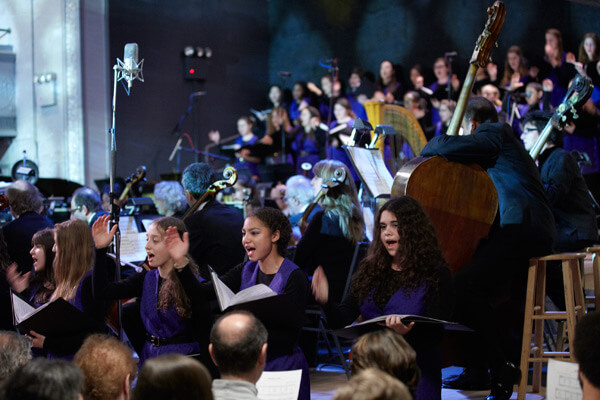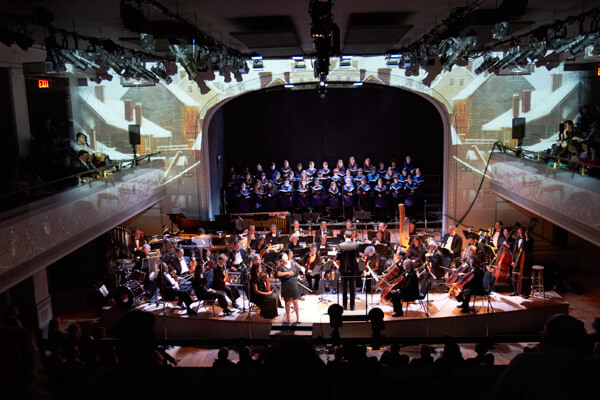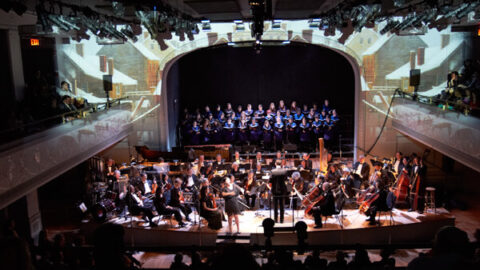 Last March, and for two nights only, Brooklyn Village was performed in Downtown Brooklyn. Advertised as a “multimedia spectacular,” the show took the audience on a time travel to honor the cultural heritage of Downtown Brooklyn, and showcased the trifecta of what some people call Brooklyn’s cultural renaissance: the newly “rebooted” Brooklyn Phil, the Brooklyn Youth Chorus (BYC) and Roulette.
Last March, and for two nights only, Brooklyn Village was performed in Downtown Brooklyn. Advertised as a “multimedia spectacular,” the show took the audience on a time travel to honor the cultural heritage of Downtown Brooklyn, and showcased the trifecta of what some people call Brooklyn’s cultural renaissance: the newly “rebooted” Brooklyn Phil, the Brooklyn Youth Chorus (BYC) and Roulette.

From the very beginning, the retro, era-bending tone was set since the program itself came in the form of a fake issue of the Brooklyn Daily Eagle whose date had been carefully smeared to remain intentionally vague. The “articles” introduced the pieces, the performers and the composers in a mockingly sensational way (Brooklyn Indie Rock Musician Sufjan Stevens Detained by NYPD). The dramatic dimension was introduced by Alan Pierson who greeted the entire hall with great enthusiasm (I’m paraphrasing): in these uncertain times of crisis, what Brooklyn needs is more music! Pierson thanked the people who bravely crossed the frozen east river on a sled, and the audience seemed to enjoy the good-natured, humorous atmosphere.
The program began with the Scherzo from Beethoven’s Eroica (Symphony No. 3—the first work played at the Brooklyn Phil’s inaugural concert in 1857): an honorable performance even though the horn section reminded us, at times, how hard their instrument is to play. The piece didn’t come to a real end as it faded out and gave way to a young singer from the BYC sharing some personal thoughts about Brooklyn, from the perspective of genuine Brooklynite while the rest of the chorus was getting on stage. Sarah K. Snider’s piece Here (2012) followed, performed impeccably, a cappella and from memory by the BYC conducted by Dianne Berkun. One never knows where to start when talking about the BYC since their overall musicianship is remarkable (solid pitch, diction, sense of shape and textures.) Snider’s musical fresco was supported by pictures of Parkslope townhouses (?) projected in the background.

The program continued with Aaron Copland’s Prelude from his Symphony No. 1 (1924/1928) with its bittersweet flute/strings doublings and crepuscular crescendi, and morphed into the next piece: Matthew Mehlan’s Canvas (2012). More hybrid in its idiom, Canvas moved through various moods and featured some very colorful instrumentations. Halfway through the piece, soprano Lauren Worsham walked on stage to sing along with 4 young boys from the BYC and they all painted a vivid image of Brooklyn with neon signs and brass hits. The first half ended with an overall tame rendition of Sufjan Stevens’ Isorhythmic Night Dance with Interchanges from “The BQE” (2007) although the flute section (David Wechsler and Jeanne Wilson) played Sufjan’s crazy arpeggios perfectly.
Even if the first half was overall musically satisfying, the program still remained far-fetched and looked like the result of a late night dare at the Brooklyn Social: start with the Eroica, end with the BQE and make it look legit.

The second half started with another dramatic episode setting the action on the imaginary final day of St. Ann’s Church in Brooklyn, about to be destroyed to give way to the Brooklyn bridge. The BYC sang Idumea (1763) by Charles Wesley—a hymn from the Shape Note tradition—and so did some audience members since a score came with the program.
Francis Guy’s painting “Winter Scene in Brooklyn” (on display at the Brooklyn Museum) was the inspiration behind Am I Born by David T. Little on a libretto by Royce Vavrek. Scored for the BKPhil, the BYC and solo soprano, Am I Born felt like a powerful musical immersion in a naive representation of a small Dutch village as well as a space/time travel (the idea behind the whole concert). The focus kept on shifting from the shopkeepers and the villagers frozen in their 1820 life to a 2012 spectator’s point of view: what does this modest piece tell us about the history of Brooklyn? About its future? What has changed? What has remained the same?
Musically speaking, David T. Little’s craft was remarkable. In a previous interview, Little told us about his collaboration with the BYC, his interest in the Shape Notes tradition, and the orchestration challenges that he had to overcome. The result was stunning: Little’s fresh orchestration, rhythmic and colorfully grounded in the low register, was emotionally effective and made great use the resources that were available to him. Each moment of icy stasis was an opportunity for (the ubiquitous) soprano Mellissa Hughes to shine and deliver Vavrek’s libretto with her most expressive voice.

I have been thinking a lot about this concert in the past weeks, trying to pinpoint what made me so uncomfortable. It may be unfair, but I can’t help but to relate this kind of project to the ongoing artisanal trend in Brooklyn (the use of the expression local composers in the press kit had something to do with it). Could one say, without playing too much on words, that the more we go local the less we go global? At which point does deserved pride turn into navel gazing? It is, of course, too early to tell and I am looking forward to the Brooklyn Philharmonic’s next season.
—
Thomas Deneuville, the founder and editor of I Care if You Listen, is a French-born composer living in NY. Find him on Twitter: @tonalfreak
























